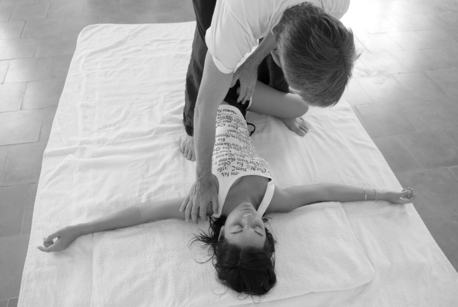Chapter 9 Additional techniques and techniques to avoid
| CHAPTER CONTENTS | |
| General contraindications | 134 |
| The blood stop – just don’t do it! | 135 |
| Applied yoga asanas | 135 |
| Spinal twists and spinal adjustments | 135 |
| The plough | 138 |
| Cobra stretches | 139 |
| Walking on the back | 141 |
| Forward bends | 142 |
| Kidney stretch | 144 |
General contraindications
Thai Massage is not medicine. Its aim is relaxation. This can be very beneficial and even healing but it is not an alternative to medical care. When we begin to practise massage the safest approach is to only work on healthy people. As we gain confidence in our practice we might choose to work with patients with medical conditions. In this case we should only do so with the knowledge and blessing of the patient’s doctor. In our practice we might come across patients where something seems wrong. It is our duty to encourage our patient to seek appropriate medical advise.
Applied yoga asanas
Thai Massage includes the application of yoga asanas. Depending on the practitioner this is a more or less important part of the overall massage. I tend to teach and use very few of the applied yoga postures. The few I use regularly have already been covered in Chapter 8. The following techniques I use occasionally. There are others that I consider too challenging for the patient and/or the practitioner so I disregard them altogether. I prefer that my patients do their own yoga practice and just come to me for the massage.
Spinal twists and spinal adjustments
There are at least four variations on the spinal twist. The one we have already looked at in Chapter 8 (Fig. 8.59) is the best as it is the patient’s own body weight that initiates the rotation in their spine. We do not push the patient’s body and if it is clear that they lack the flexibility or the willingness to turn we do not continue.
When we make contact it is simply to draw the patient’s attention to the way their body tightens a little with inhalation and relaxes a little with exhalation. They learn to breath their way into the rotation (Fig. 9.1).
Stay updated, free articles. Join our Telegram channel

Full access? Get Clinical Tree







